WORKSHEET ON TRIANGLE
1. Is it possible to have a triangle whose sides are 5 cm, 6 cm and 4 cm?
2. Two sides of a triangle have the measures 6 and 7. Find the range of possible measures for the third side.
3. Can 30°, 60° and 90° be the angles of a triangle?
4. In a triangle, If the second angle is 5° greater than the first angle and the third angle is 5° greater than second angle, find the three angles of the triangle.
5. In an isosceles triangle, if the measure of each of the two equal angles is 55°, find the measure of the third angle.
6. Find m∠W and m∠X in the triangle given below.

7. Find the area and perimeter of the triangle given below.
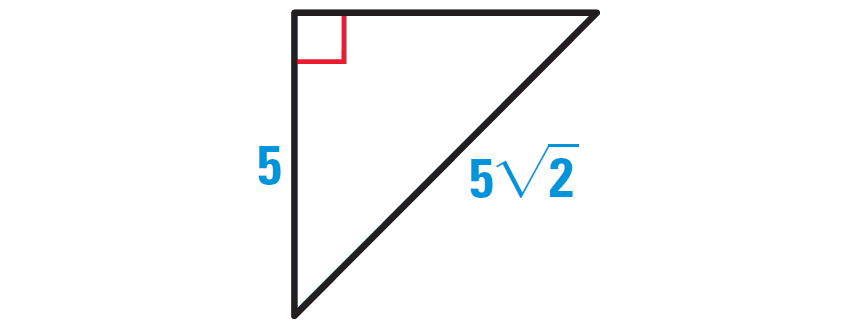
8. If the perimeter of the triangle shown below is 101 cm, find the value of x.

9. Find the perimeter of the triangle defined by the following points :
D(1, 3), E(8, 3) and F(4, 7)
10. Find the area of triangle whose vertices are (-3, -9), (3, 9) and (5, -8).
11. Find the length of the hypotenuse in the triangle shown below.
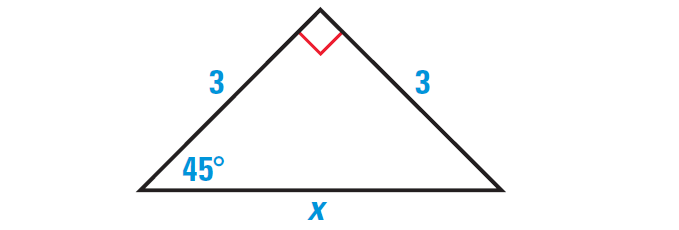
12. Find the value of s and x in the triangle shown below.

13. Determine whether the two triangles given below are similar. Justify your answer.
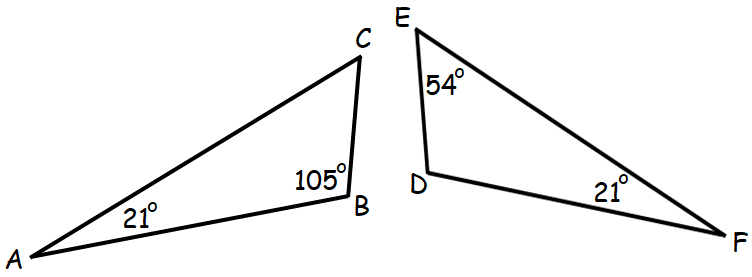
14. In the diagram given below, if AC and DE are parallel, find the value of h.
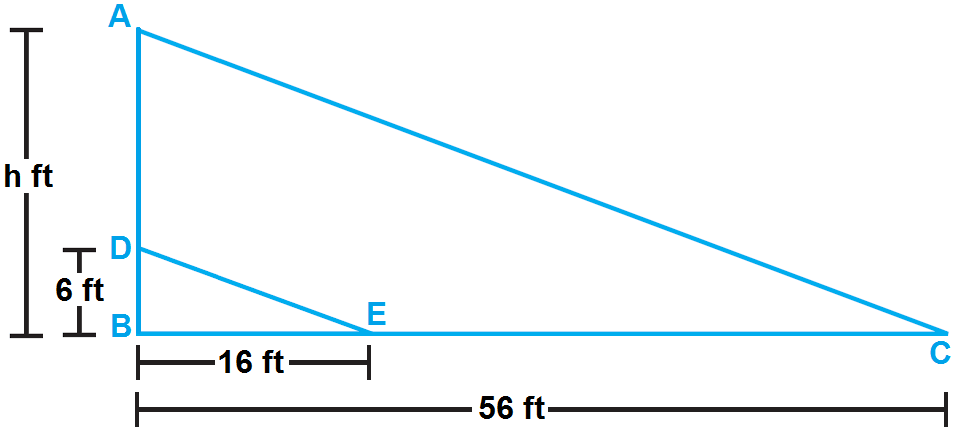
15. In the diagram below, prove that ΔABC ≅ ΔFGH.
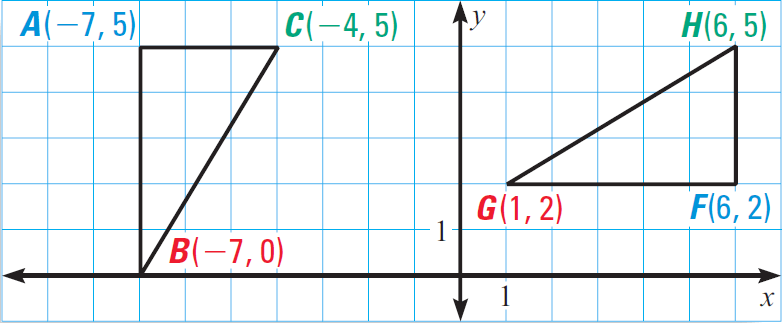
16. In the diagram below, prove that ΔAEB ≅ ΔDEC.

17. In the diagram below, prove that ΔABD ≅ ΔEBC.
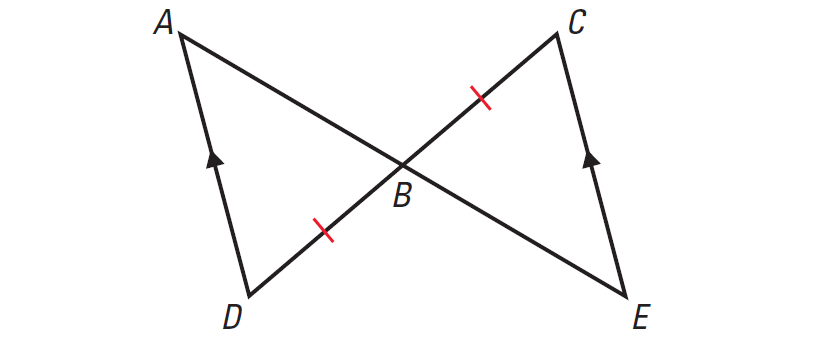
18. In the figure below, which of the following ratios has the same value as AB/BC?
(A) BD/DC (B) BC/AC (C) AD/BD (D) DC/BC
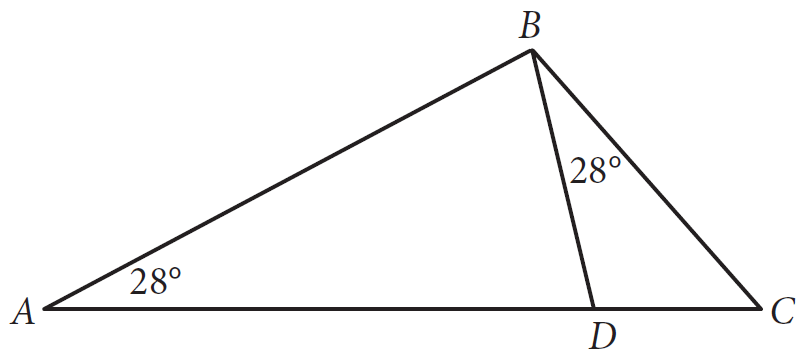
19. Triangle ABC shown below is an isosceles triangle with AB = AC and BC = 48. The ratio of DE to DF is 5 : 7. What is the length of DC?
(A) 12 (B) 20 (C) 24 (D) 28
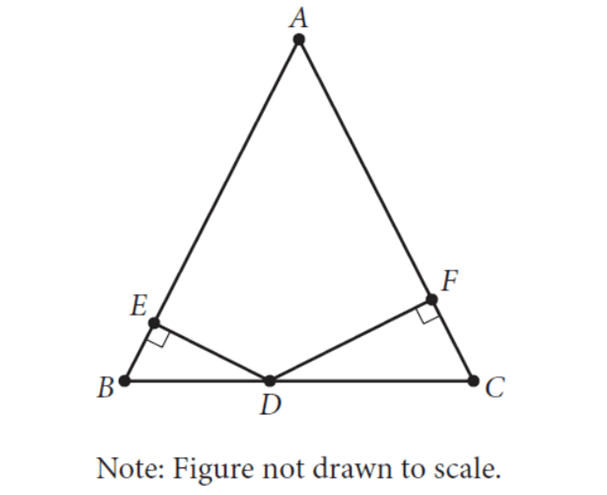
20. A summer camp counselor wants to find a length, x, in feet, across a lake as represented in the sketch below. The lengths represented by AB, EB, BD, and CD on the sketch were determined to be 1800 feet, 1400 feet, 700 feet, and 800 feet, respectively. Segments AC and DE intersect at B, and ∠AEB and ∠CDB have the same measure. What is the value of x?
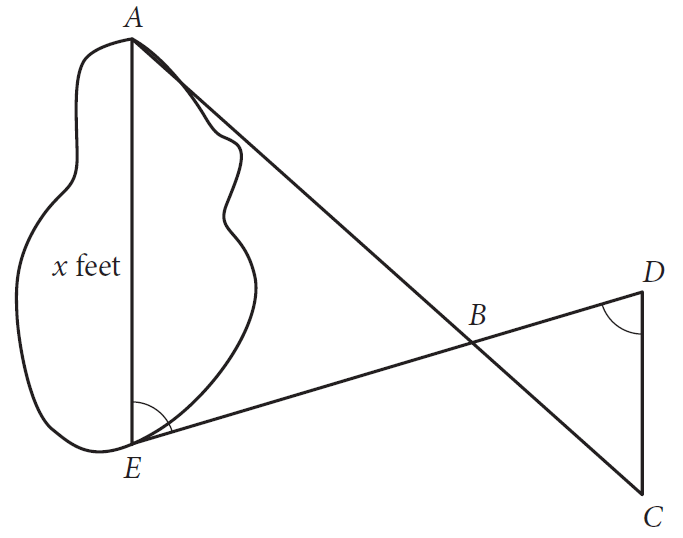

1. Answer :
If the sum of the lengths of any two sides is greater than the third side, then the given sides will form a triangle.
Let us apply this property for the given sides.
5 cm + 6 cm > 4 cm
6 cm + 4 cm > 5 cm
5 cm + 4 cm > 6 cm
Since the given sides meet the condition said in the property, it is possible to have a triangle whose sides are 5 cm, 6 cm and 4 cm.
2. Answer :
Lengths of the given two sides are 6 and 7.
Let x be the the length of the third side.
Difference of the lengths = 7 - 6 = 1
Sum of the lengths = 7 + 6 = 13
The range of possible measures for the third side is
1 < x < 13
3. Answer :
Add all the three given angles and check whether they add up to 180°.
30° + 60° + 90° = 180°
Because the given angle measures add up to 180°, the given three angles can be the angles of a triangle.
4. Answer :
Let x be the first angle.
Then,
second angle = x + 5
third angle = x + 5 + 5 = x + 10
We know that,
the sum of the three angles of a triangle = 180°
x + (x + 5) + (x + 10) = 180
3x + 15 = 180
3x = 165
x = 55
first angle = 55°
second angle = 55 + 5 = 60°
third angle = 60 + 5 = 65°
So, the three angles of a triangle are 55°, 60° and 65°.
5. Answer :
Let x be the measure of the third angle.
x + 55° + 55° = 180°
x + 110° = 180°
x = 70°
The measure of the third angle is 70°.
6. Answer :
Write the Exterior Angle Theorem as it applies to this triangle.
m∠W + m∠X = m∠WYZ
Substitute the given angle measures.
(4y - 4)° + 3y° = 52°
Solve the equation for y.
(4y - 4)° + 3y° = 52°
4y - 4 + 3y = 52
Combine the like terms.
7y - 4 = 52
Add 4 to both sides.
7y - 4 + 4 = 52 + 4
Simplify.
7y = 56
Divide both sides by 7.
y = 8
Use the value of y to find m∠W and m∠X.
|
m∠W = 4y - 4 m∠W = 4(8) - 4 m∠W = 28° |
m∠X = 3y m∠X = 3(8) m∠X = 24° |
7. Answer :
Because we want to find the area of the triangle, we have to know its base and height.
To know the base and height of the triangle, let us rotate the given triangle as shown below.
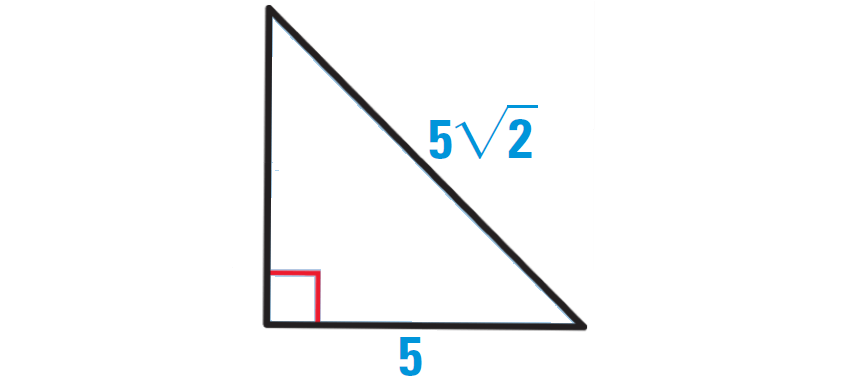
Use Pythagorean theorem to find the height of the triangle.
h2 + 52 = (5√2)2
h2 + 25 = 52 ⋅ (√2)2
h2 + 25 = 25 ⋅ 2
h2 + 25 = 50
Subtract 25 from each side.
h2 = 25
h2 = 52
h = 5
Area of the triangle :
= (1/2) ⋅ base ⋅ height
= (1/2) ⋅ 5 ⋅ 5
= 12.5 square units
Perimeter of the triangle :
= Sum of the lengths of all the three sides
= 5 + 5 + 5√2
= (10 + 5√2) units
8. Answer :
The given triangle is an isosceles triangle and the length of each of the two equal sides is (x + 3) cm.
Perimeter of the triangle = 101 cm
(x + 3) + (x + 3) + (x + 5) = 101
x + 3 + x + 3 + x + 5 = 101
3x + 8 = 101
Subtract 8 from each side.
3x = 93
Divide each side by 3.
x = 31
9. Answer :
Plot the points in the coordinate plane. Draw the height from F to the side DE. Label the point where the height meets DE as G. Point G has coordinates (4, 3).
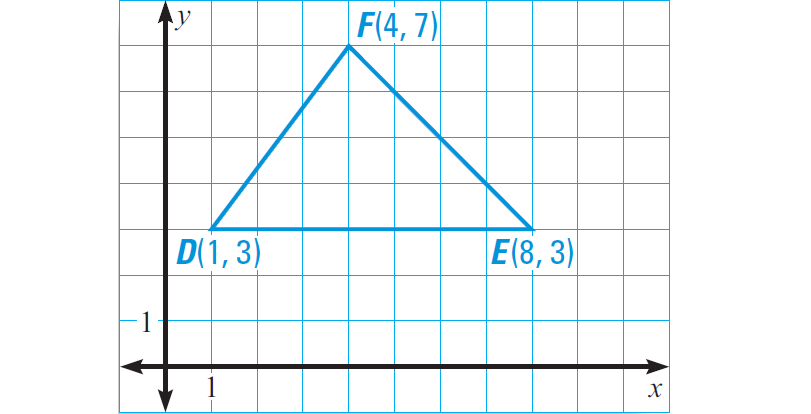
Length of DE :
= 8 - 1
= 7
Use distance formula to find the length of EF and FD.
Distance Formula :
= √[(x2 - x1)2 + (y2 - y1)2]
Length of EF :
(x1, y1) = E(8, 3)
(x2, y2) = F(4, 7)
EF = √[(4 - 8)2 + (7 - 3)2]
EF = √[(-4)2 + (4)2]
EF = √[16 + 16]
EF = √32
EF = √(4 ⋅ 4 ⋅ 2)
EF = 4√2
Length of FD :
(x1, y1) = F(4, 7)
(x2, y2) = D(1, 3)
FD = √[(1 - 4)2 + (3 - 7)2]
FD = √[(-3)2 + (-4)2]
FD = √[9 + 16]
FD = √25
FD = 5
Perimeter of the triangle :
= 5 + 7 + 4√2
= (12 + 4√2) units
10. Answer :
Plot the given points in the xy plane.
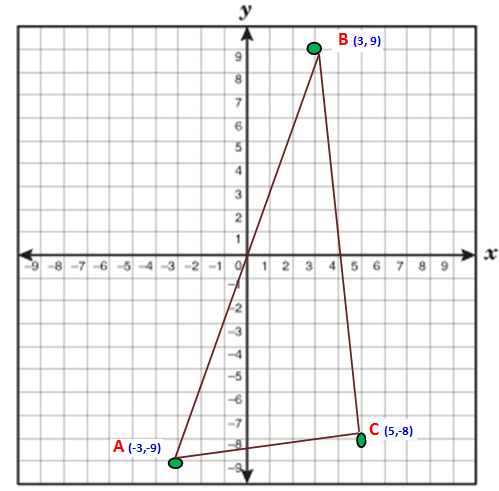
Now we have to take anticlockwise direction. So we have to take the points in the order B(3, 9), A(-3, -9) and C(5, -8)
x1 = 3 x2 = -3 x3 = 5
y1 = 9 y2 = -9 y3 = -8
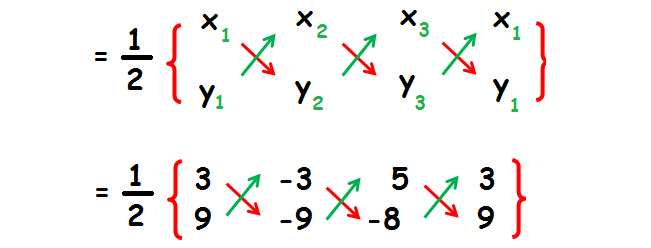
Area of the triangle BAC
= (1/2) {(-27 - 24 + 45) - (-27 - 45 - 24)}
= (1/2) {(-51 + 45) - (-96)}
= (1/2) {-6 + 96}
= (1/2) (90)
= (90/2)
= 45 Square units.
11. Answer :
By the Triangle Sum Theorem, the measure of the third angle is 45°.
The triangle is a 45°-45°-90° right triangle, so the length x of the hypotenuse is √2 times the length of a leg.
By 45°-45°-90° Triangle Theorem, we have
Hypotenuse = √2 ⋅ leg
In any right angled triangle, the side which is opposite the right angle is hypotenuse. In the triangle shown above, x represents hypotenuse. Because, the side x represents is opposite the right angle.
Substitute.
x = √2 ⋅ 3
Simplify.
x = 3√2
So, the length of the hypotenuse is 3√2.
12. Answer :
Finding the value of s :
Because the triangle is a 30°-60°-90° triangle, the longer leg is √3 times the length s of the shorter length.
By 30°-60°-90° Triangle Theorem, we have
Longer leg = √3 ⋅ shorter leg
Substitute.
5 = √3 ⋅ s
Divide each side by √3.
5/√3 = s
To rationalize the denominator, multiply numerator and denominator by √3.
(√3/√3) ⋅ (5/√3) = s
5√3/3 = s
Finding the value of x :
By 30°-60°-90° Triangle Theorem, the length x of the hypotenuse is twice the length s of the shorter leg.
So, we have
Hypotenuse = 2 ⋅ shorter leg
Substitute.
x = 2 ⋅ (5√3/3)
x = 10√3/3
13. Answer :
By Triangle Sum Theorem, in Δ ABC,
∠A + ∠B + ∠C = 180°
21° + 105° + ∠C = 180°
126° + ∠C = 180°
Subtract 126° from both sides.
∠C = 54°
In triangles ABC and DEF, we have
∠A = ∠F = 21°
∠E = ∠C = 54°
Two angles of one triangle are congruent to two angles of another triangle.
By Third Angle Theorem, the third pair of angles must also be congruent.
That is,
∠B = ∠D = 105°
So, the triangles ABC and DEF are similar triangles.
14. Answer :
In the above diagram, we can consider two triangles ABC and DBE.
Given : AC and DE are parallel.
The parallel sides AC and DE are cut by the transversal EC.
Then ∠E and ∠C are corresponding angles.
When two parallel lines cut by a transversal, the corresponding angles are congruent.
So, ∠E and ∠C are congruent.
In triangles ABC and DBE, we have
∠E ≅ ∠C
∠B is common angle
Two angles of one triangle are congruent to two angles of another triangle.
By Third Angle Theorem, the third pair of angles must also be congruent.
So, the triangles ABC and DBE are similar triangles.
In similar triangles, the ratio of the corresponding sides are equal.
Then, we have
AB/DB = BC/BE
Substitute AB = h, DB = 6, BE = 16 and BC = 56.
h/6 = 56/16
Multiply both sides by 6.
h = 21
15. Answer :
Because AB = 5 in triangle ABC and FG = 5 in triangle FGH,
AB ≅ FG
Because AC = 3 in triangle ABC and FH = 3 in triangle FGH,
AC ≅ FH
Use the distance formula to find the lengths of BC and GH.
Length of BC :
BC = √[(x2 - x1)2 + (y2 - y1)2]
(x1, y1) = B(-7, 0) and (x2, y2) = C(-4, 5)
BC = √[(-4 + 7)2 + (5 - 0)2]
BC = √[32 + 52]
BC = √[9 + 25]
BC = √34
Length of GH :
GH = √[(x2 - x1)2 + (y2 - y1)2]
(x1, y1) = B(1, 2) and (x2, y2) = C(6, 5)
GH = √[(6 - 1)2 + (5 - 2)2]
GH = √[52 + 32]
GH = √[25 + 9]
GH = √34
Conclusion :
Because BC = √34 and GH = √34,
BC ≅ GH
All the three pairs of corresponding sides are congruent. By SSS congruence postulate,
ΔABC ≅ ΔFGH
16. Answer :
|
Statements AE ≅ DE, BE ≅ CE ∠1 ≅ ∠2 ΔAEB ≅ ΔDEC |
Reasons Given Vertical Angles Theorem SAS Congruence Postulate |
17. Answer :
|
Statements BD ≅ BC AD || EC ∠D ≅ ∠C ∠ABD ≅ ∠EBC ΔABD ≅ ΔEBC |
Reasons Given Given Alternate Interior Angles Theorem Vertical Angles Theorem ASA Congruence Postulate |
18. Answer :
We can separate the two triangles as shown below.

In the above two triangles,
m∠C = m∠C (common angle)
m∠A = m∠B = 28°
By AA Similarity Postulate, ΔABC and ΔBDC are similar.
So the corresponding sides are proportional.
AB/BD = BC/DC = AC/BC
Let's take the first two ratios in the above proportion.
AB/BD = BC/DC
AB/BC = BD/DC
The correct answer is (A).
19. Answer :
m∠E = m∠F = 90°
Since triangle ABC above is isosceles with AB = AC,
m∠B = m∠C
By Angle-Angle (AA) similarity postulate, triangles BED and CFD are similar.
DB/DC = DE/DF
Given : DE/DF = 5/7.
DB/DC = 5/7
DC/DB = 7/5
5(DC) = 7(DB) ----(1)
Given : BC = 48.
BC = 48
DB + DC = 48
DB = 48 - DC
Substitute (48 - DC) for DB in (1).
5(DC) = 7(48 - DC)
5(DC) = 336 - 7(DC)
12(DC) = 336
DC = 28
The correct answer is (D).
20. Answer :
In ΔAEB and ΔCDE,
m∠AEB = m∠CDB (given)
m∠ABE = m∠CBD (vertical angles)
By AA Similarity Postulate, ΔAEB and ΔCDE are similar.
So, the corresponding sides are proportional.
AE/CD = BE/BD
Substitute AE = x, BE = 1400, BD = 700 and CD = 800.
x/800 = 1400/700
x/800 = 1400/700
x/800 = 2
Multiply each side by 800.
x = 1600
Kindly mail your feedback to v4formath@gmail.com
We always appreciate your feedback.
©All rights reserved. onlinemath4all.com
Recent Articles
-
Trigonometry Even and Odd Iidentities
May 05, 24 12:25 AM
Trigonometry Even and Odd Iidentities -
SOHCAHTOA Worksheet
May 03, 24 08:50 PM
SOHCAHTOA Worksheet -
Trigonometry Pythagorean Identities
May 02, 24 11:43 PM
Trigonometry Pythagorean Identities

